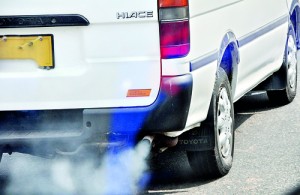News
Clearing the air on vehicle emission tests with greater vigilance
The emission tests conducted on vehicles – a pre-requisite for a revenue licence – is supposed to be a measure to improve air quality, but the exercise could prove futile as the Motor Traffic Dept (MTD) found out recently.
A careful study of the emission test data recorded with the MTD revealed that the results from a particular centre in Pugoda, in the Gampaha district, were identical. At least 35 reports issued for different vehicles from the centre, had the same data.
A check conducted at the centre revealed that the test results were from the same vehicle, with only the number plate of the vehicle changed.

‘Smoking culprits’: How efficient is the emission test?
This was one of some 18 instances detected by the MTD where either the test results were manipulated, or the test equipment adjusted, or fraudulent certificates issued, as the vehicles failed to meet the required emission levels set by the Central Environmental Authority. Ajith Silva, Environmental Ministry Director – Air Quality, told the Sunday Times that as many as 10 centres which issued bogus emission test certificates, were sealed, with over 200 workers attached to these centres, having their services terminated. Several others found guilty of minor offences were transferred.
“We have found that there are several ways of manipulating the tests results, with three-wheeler owners and motorcyclists submitting the largest number of fraudulent test results,” he said.
He said that some believe that it is only a matter of obtaining a clear emission test certificate, but do not realise that failing the test also means adjustments or repairs to the vehicle.
‘Some of the three-wheelers or motor cycles fill the silencer with water before coming for the test, little realising that, in the process, the silencer gets corroded. This is more expensive than effecting repairs or adjustments,” he said.
Furthermore, testing such ‘doctored’ vehicles could also damage the testing equipment, with each machine costing about Rs. 5 million. “Therefore, workers should make sure not to test such vehicles,” he added.
He said some of them remove the air filter before bringing the vehicle for the test. This too damages the vehicle as dust gets drawn in unhindered and damages the engine.
“We are also aware that there are garage owners close to these centres which provide temporary solutions to vehicles, so that a clear emission test certificate could be obtained,” he said.
The vehicle emission test was made compulsory in 2008 in a bid to improve air quality.
A recent test carried out in the main towns revealed that the air quality had shown improvement, prompting a committee studying the subject, to propose that vehicle emission tests be conducted bi-annually, instead of annually. The tests were carried out in Colombo, Gampaha, Kalutara, Ratnapura and Galle districts. Sulfur dioxide and nitrogen dioxide levels were measured during these tests. Mr. Silva said that in order to improve air quality and ensure that the vehicle emission test certificates provide accurate results, a series of steps have been planned.
“We hope to carry out random checks on vehicles leaving emission test centres, to ensure that the results obtained from the centre are accurate,” he said.
He said laws will be made to act against persons issuing false certificates.
He said, in addition, it is hoped to conduct random checks on vehicles and, if emissions levels are high, give the owners up to a fortnight to effect repairs/adjustments. Failure to do so would mean blacklisting the vehicle, with the vehicle owner unable to do any transactions including transfer of vehicles through the MTD. Deputy Inspector General of Police (Traffic) Amarasiri Senaratne told the Sunday Times that the Vehicle Emission Test report should always be in the vehicle, and failure to do so would render the owner liable to a fine.

